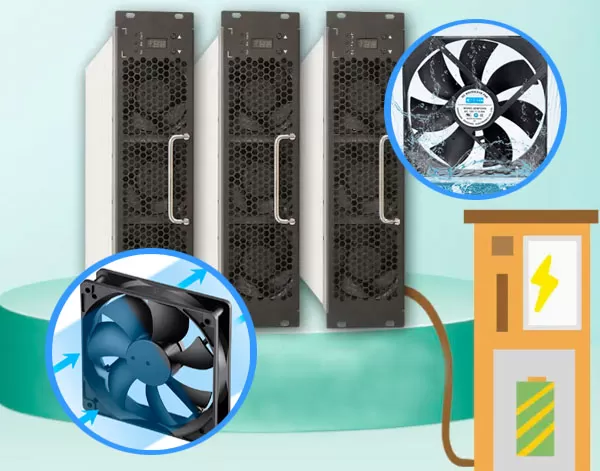Function
Prevent the charging module from overheating, ensure that it works within a safe temperature range, and avoid performance degradation, shortened life, or even damage caused by high temperature.
Maintain the stable performance of the charging module, ensure charging efficiency and power output, and prevent charging interruption or failure caused by overheating.

Working principle
Air cooling: The charging module cooling fan usually adopts air cooling, and the rotation of the fan drives the air flow, so that the heat is dissipated from the heat sink or heating element surface of the charging module to the surrounding air to achieve cooling. For example, in the charging pile, when the charging module is working, the cooling fan will transfer the heat generated inside the charging pile to the air through the radiator.
Main types
Axial flow fan: The airflow flows along the direction of the fan axis, with the characteristics of large air volume and high efficiency. It is suitable for charging modules with high heat dissipation requirements and relatively open space, such as charging modules in high-power charging piles.
Centrifugal fan: The airflow enters from the axial direction of the fan and flows out radially, which can generate higher wind pressure. It is suitable for use in charging modules with limited space and complex heat dissipation channels, such as some small charging devices or charging modules with high integration.
Main parameters
Size: Common specifications include 40mm×40mm, 60mm×60mm, 80mm×80mm, 92mm×92mm, etc. The size determines the installation position and applicable scenarios of the fan. For example, a small wireless charging module may use a 40mm×40mm fan, while a charging module for a large charging pile may use a 80mm×80mm or larger fan.
Voltage: Generally, there are 5V, 12V, 24V, etc. When choosing, it needs to be determined according to the power system and design requirements of the charging module to ensure that the fan can work normally. For example, some on-board charging modules will use 12V or 24V cooling fans to match the vehicle power system.
Speed: The higher the speed, the greater the air volume generated by the fan, and the better the heat dissipation effect, but it will also bring greater noise. The common speed range is between 1000RPM and 20000RPM. The specific speed requirement depends on the heat generation power and heat dissipation requirements of the charging module. For example, a high-power charging module may require a fan with a higher speed to ensure the heat dissipation effect.
Air volume: refers to the volume of air passing through the fan per unit time, in units of CFM (cubic feet per minute) or m³/h (cubic meters per hour). The larger the air volume, the stronger the heat dissipation capacity. Generally, the fan with appropriate air volume is selected according to the heat dissipation requirements and design of the charging module. For example, a high-power charging module requires a larger air volume to remove the generated heat.
Noise level: usually measured in decibels (dB). The lower the noise, the better the user experience. In some places with high noise requirements, such as charging piles indoors or in residential areas, it is necessary to select a cooling fan with a lower noise level.
Application
Charging pile: including AC charging piles and DC charging piles, used to charge electric vehicles. The charging module will generate a lot of heat during the charging process. The cooling fan can effectively reduce the temperature of the charging module and ensure the stable operation and charging efficiency of the charging pile.
Wireless charging module: such as mobile phone wireless charging module, electric vehicle wireless charging module, etc., will also generate heat during charging. The cooling fan helps to improve the charging speed and safety and prevent overheating from damaging the equipment.
Development trend
Efficient heat dissipation: With the development of charging technology, the power of the charging module continues to increase, and the requirements for the heat dissipation efficiency of the cooling fan are also getting higher and higher. In the future, the cooling fan will continue to optimize the design and manufacturing process, and improve the performance indicators such as air volume and air pressure to meet the heat dissipation needs of high-power charging modules.
Low noise: In the context of people's increasing requirements for the quality of living environment, reducing the noise level of the cooling fan will become an important development direction. By adopting advanced motor technology, optimizing fan blade design and improving bearing structure, the noise generated by the fan during operation can be reduced.
Intelligence: Cooling fans with intelligent speed regulation function will be more widely used. The temperature of the charging module is monitored in real time through temperature sensors and other components, and the fan speed is automatically adjusted according to temperature changes to achieve precise heat dissipation and energy saving and consumption reduction.
Miniaturization and integration: As electronic devices develop towards miniaturization and integration, charging modules are becoming more and more compact. This requires cooling fans to achieve smaller size and higher integration while ensuring heat dissipation performance to adapt to narrow installation spaces.


 +86-13528507673
+86-13528507673
 E-mail
E-mail
